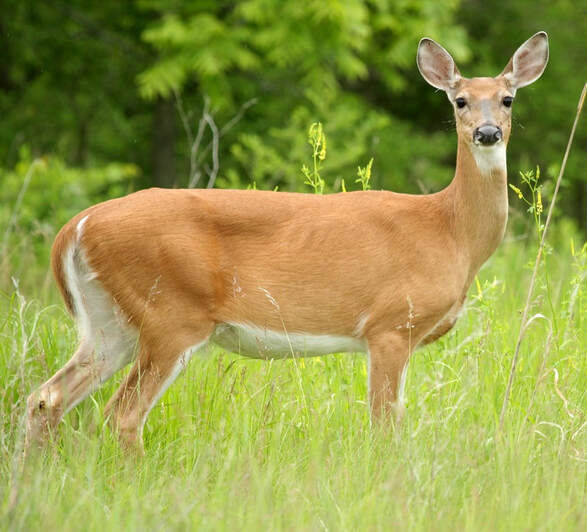Snowshoe, West Virginia is a beautiful mountain resort area located in the Allegheny Mountains. The region is home to a diverse range of wildlife that has adapted to the cold winters and mountainous terrain. Some of the common wildlife species found in Snowshoe, WV include:

1. White-tailed deer: These majestic creatures are a very common sight in the region. They can be seen grazing in open fields or walking along the forested areas and can be seen all throughout Snowshoe. With some of our condos at Summit, these deer LOVE to hang around and even bring the whole deer family around. Truly a beautiful experience to have with your family and little children love it.

2. Black bears: Snowshoe is also home to a healthy population of black bears. These animals are shy and elusive, but visitors may be able to spot them in the early morning or late evening. Every now and then a bear will come to visit. Don't panic and don't startle the bear. Go for safety until the bear has passed and enjoy this beautiful animal.

3. Red foxes: These small, agile predators have adapted well to the region's cold winters and mountainous terrain. With their bright red fur and bushy tails, they are easily recognizable and a favorite among wildlife enthusiasts. Red foxes can be seen darting through the snow in search of prey, which can include small mammals like rabbits, rodents, and birds. They are known for their intelligence and cunning, which makes them skilled hunters. Despite their reputation for being shy and elusive, red foxes in Snowshoe can sometimes be spotted in the early morning or late evening as they move through the forests and fields of the region.

4. Snowshoe hares: Snowshoe hares are a species of hare that are well adapted to the snowy climate of the Snowshoe, WV region. These small mammals have a thick, white coat of fur that helps them blend in with their surroundings, making them difficult to spot by predators such as lynx, bobcats, and coyotes. During the summer months, their fur turns brown to better match the forest floor.

5. Birds: Snowshoe is a great place for birdwatchers, with a variety of species including eagles, red-tail hawks, barred owls, songbirds, woodpeckers, and waterfowl.

6. Reptiles and amphibians: While the winters can be harsh in Snowshoe, the region is home to several species of snakes, turtles, and frogs that can be found in the warmer months. Some specific reptiles and amphibians that could be found are the Eastern newts, Northern water snakes, Eastern box turtles, Red-backed salamanders, American toads, and Timber rattle snakes.

7. Bobcats: They are elusive and primarily nocturnal, so sightings of them are relatively rare. These animals have a distinctive appearance, with short, reddish-brown fur and black spots on their underbelly. In Snowshoe, bobcats can be found in a variety of habitats, including forests, meadows, and rocky areas. They are solitary animals and tend to avoid humans, but they can occasionally be spotted in the early morning or late evening hours.

8. Raccoons: These animals are known for their distinctive appearance, with dark fur, a black mask around their eyes, and a bushy tail with alternating light and dark rings. Raccoons are omnivores and have a varied diet, including fruits, nuts, insects, small mammals, and even garbage. They are also excellent climbers and can often be found raiding bird feeders or climbing trees in search of food. In Snowshoe, raccoons can be found in a variety of habitats, including forests, fields, and suburban areas. They are known for their adaptability and ability to thrive in human-dominated landscapes.

9. Eastern cottontails: These rabbits are easily recognizable by their distinctive appearance, with short, fluffy tails that resemble cotton balls and large, pointed ears. Eastern cottontails are herbivores and feed on a variety of plants, including grasses, clovers, and wildflowers. They are an important food source for many predators in the Snowshoe ecosystem, including bobcats, foxes, and birds of prey. In Snowshoe, Eastern cottontails can be found in a variety of habitats, including forests, fields, and suburban areas. They are a common sight in the early morning and late evening hours, when they are most active.

10. Coyotes: They are a relatively recent addition to the wildlife of Snowshoe, WV. These animals are members of the canid family, which includes dogs, wolves, and foxes. Coyotes are generally medium-sized animals with a slender build and a distinctive, pointed muzzle. Coyotes are opportunistic predators and have a varied diet, including small mammals, birds, reptiles, and insects. They are also known to scavenge on carrion and will sometimes prey on domestic livestock. In Snowshoe, coyotes can be found in a variety of habitats, including forests, fields, and suburban areas. They are primarily nocturnal and tend to avoid humans, but they have been known to raid garbage cans and pet food dishes.
Overall, Snowshoe, WV offers a unique opportunity to observe a diverse range of wildlife in a beautiful natural setting. Just remember to always take care of our wildlife. Be respectful, leave them alone in nature, and always pick up after yourself. That is how we keep our Snowshoe the beautiful land it is.
Visit our properties today to see the Snowshoe beauty! 107D Summit: https://www.frangoulesproperties.com/107d-summit-drive
305 Soaring Eagle: https://www.frangoulesproperties.com/305-soaring-eagle

Comments